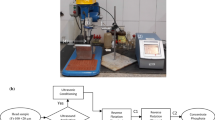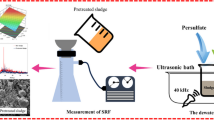Abstract
A process for treating low radioactive uranium wastewater by ultrasonic combined flocculation and precipitation has been developed and optimized. By using arsenazo III spectrophotometry to detect the mass concentration of uranium ions, the optimal coupling mode of ultrasonic flocculation and the optimal values of pH value, flocculant dosage, and ultrasonic power were obtained through single factor experiments. The conclusion drawn is that the optimal coupling method is to first add flocculants, then treat the solution with ultrasound, and finally stir the solution. The optimal values for each single factor are: the initial pH value of the solution is 9, the dosage of flocculant is 80 mg/L, and the sound energy density is 0.36 W/ml.The Box Behnken response surface experiment was designed using Design-Expert software. After completing the response surface experiment, a regression model for uranium ion removal rate was obtained. The highest uranium ion removal rate under theoretical conditions was obtained by solving the model.The predicted values of uranium ions removal rate of 95.68% was obtained with an acoustic energy density of 0.436 W/ml and a flocculant dosage of 88 mg/L at pH 9.It was observed that the actual experimental data under the same conditions are 95.41% The order of the influence factors of each process parameter on the uranium ion removal rate is: pH > flocculant dosage > ultrasonic power. Among them, there was a significant interaction between ultrasonic power and flocculant dosage.



Similar content being viewed by others
References
Pant D, Keesari T, Roy A, Sinha UK, Singh M, Jain SK, Tripathi RM (2019) Study on groundwater quality in parts of Rajasthan with special reference to uranium contamination. J Radioanal Nuclear Chem 322:165–171
Long X, Yu Z, Liang X, Diao Z, Song G, Chen D, Kong L (2023) Understanding the artificial mineralized uranite for immobilizing uranium in wastewater. J Clean Prod 384:135494
Wufuer R, Wei Y, Lin Q, Wang H, Song W, Liu W, Gadd GM (2017) Uranium bioreduction and biomineralization. Adv Appl Microbiol 101:137–168
Prasad M, Semwal P, Panwar P, Gusain GS, Ramola RC (2022) Uranium contamination in drinking water as a health concern in Uttarakhand, India. J Radioanal Nuclear Chem 331(4):1933–1940
Singh J, Dutta PK (2009) Preparation, circular dichroism induced helical conformation and optical property of chitosan acid salt complexes for biomedical applications. Int J Biol Macromol 45(4):384–392
Yang A, Yang P, Huang CP (2017) Effect of Mg (II) on the removal of uranium from low radioactive wastewater by flocculation using polyacrylamide. J Hazard, Toxic, Radioact Waste 21(4):04017006
Tang Y et al (2023) In situ chemical oxidation-grafted amidoxime-based collagen fibers for rapid uranium extraction from radioactive wastewater. Sep Purif Technol 307:122826
Fengzhen W, Xianghong F (2009) Experimental research on the vacuum evaporating device and its application to the treatment of radioactive wastewater. Ind Water Treat 29(09):62–65
Yin Ye et al (2022) Electrochemical removal and recovery of uranium: effects of operation conditions, mechanisms, and implications. J Hazard Mater 432:128723–128723
Mkandawire M, Dudel EG (2005) Accumulation of arsenic in Lemna gibba L.(duckweed) in tailing waters of two abandoned uranium mining sites in Saxony Germany. Sci Total Environ 336(1–3):81–89
Nie X, Hu X, Liu C, Xia X, Dong F (2021) Decontamination of uranium contained low-level radioactive wastewater from UO2 fuel element industry with vacuum membrane distillation. Desalination 516:115226
Li S, Zhu Q, Luo J, Shu Y, Guo K, Xie J, He S (2021) Application progress of deinococcus radiodurans in biological treatment of radioactive uranium-containing wastewater. Indian J Microbiol 61(4):417–426
Swain L, Pakhui G, Jain A, Ghosh S (2022) Electrochemical behaviour of LiCl-KCl eutectic melts containing moisture as impurity. Part II Uranium electrode. J Electroanal Chem 907:115969
Xing C, Bernicot B, Arrachart G, Pellet-Rostaing S (2023) Application of ultra/nano filtration membrane in uranium rejection from fresh and salt waters. Sep Purif Technol 314:123543
Oliveira MDCTBE, Rosentrater KA (2020) An environmental and economic analysis of flocculation technology applied to a corn-based ethanol plant. Processes 8(3):271
Kim SI, Song JS (2018) A study on the evaluation of cesium removal performance in soil washing process using flocculating agent. J Radioanal Nuclear Chem 316:1227–1232
Gäfvert T, Ellmark C, Holm E (2002) Removal of radionuclides at a waterworks. J Environ Radioact 63(2):105–115
Ji JB, Lu XH, Cai MQ, Xu ZC (2006) Improvement of leaching process of Geniposide with ultrasound. Ultrason Sonochem 13(5):455–462
Xin WANG, Srinivasakannan C, Xin-hui DUAN, Jin-hui P, Da-jin Y (2013) Leaching kinetics of zinc residues augmented with ultrasound. Sep Purif Technol 115:66–72
Jun W, Jiantao H, Yang Z (2002) The application of ultrasound technology in chemical production. Contemp Chem Ind 12(4):187–189
Liao T, Feng T, Li J, Hu J, Yang L, Zhang L (2021) Pilot-scale removal of uranium from uranium plant wastewater using industrial iron powder in the ultrasonic field. Ann Nuclear Energy 150:107876
Su-Xia H, Ji-Jun L, Bin H, Ru-Song L, Tao S (2014) The treatment of radioactive wastewater by ultrasonic standing wave method. J Hazard Mater 274:41–45
Pranvera L (2000) Determination of uranium by spectrophotometric method with Arsenazo III. Asian J Chem: Int Quart Res J Chem 12(3):732–738
Wu X, Ge X, Wang D, Tang H (2007) Distinct coagulation mechanism and model between alum and high Al13-PACl. Colloids Surfaces A: Physicochem Eng Aspects 305(1–3):89–96
Liu YH, Wang YQ, Zhang ZB, Cao XH, Nie WB, Li Q, Hua R (2013) Removal of uranium from aqueous solution by a low cost and high-efficient adsorbent. Appl Surface Sci 273:68–74
Zhang M, Xu Z, Wang L (2022) Ultrasonic treatment improves the performance of starch as depressant for hematite flotation. Ultrason Sonochem 82:105877
Niu ZR, Liu Y, Li DH et al (2014) Optimization of sludge-based activated carbon preparation using response surface methodology. Acta Sci Circumstantiae 34(12):3022
Li YK, Li Y, Sun YH, Zhou BX, Zhou XP (2016) Correlation analysis between Zeta potential and mud flocculation and dewatering capacity on mud flocculation experiment. J Waterway Harbor 37(02):187–192
Kong HX, Huang YC et al (2009) Study on decoloration of syrup by flocculant cooperate with ultrasonic wave. Food Sci Technol 34(07):63–66
Acknowledgements
I would like to express my gratitude to all those who helped me during the writing of this thesis, especially Feng wendong and Qing fengdi, for their constant encouragement and guidance. The research work is supported by the National Natural Science Foundation of China (Grant No. 11875035).
Author information
Authors and Affiliations
Corresponding author
Ethics declarations
Conflict of interest
Authors have no conflict of interest to declare.
Additional information
Publisher's Note
Springer Nature remains neutral with regard to jurisdictional claims in published maps and institutional affiliations.
Rights and permissions
Springer Nature or its licensor (e.g. a society or other partner) holds exclusive rights to this article under a publishing agreement with the author(s) or other rightsholder(s); author self-archiving of the accepted manuscript version of this article is solely governed by the terms of such publishing agreement and applicable law.
About this article
Cite this article
Wu, T., Huang, H., Sun, W. et al. Study on ultrasonic flocculation combined treatment of low radioactive uranium wastewater. J Radioanal Nucl Chem 332, 3711–3718 (2023). https://doi.org/10.1007/s10967-023-09040-x
Received:
Accepted:
Published:
Issue Date:
DOI: https://doi.org/10.1007/s10967-023-09040-x




